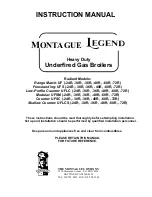
4
050611.01
vetus®
Water Heater WHxxC
1 Introduction
Tap water in the calorifier inner tank is heated by engine coolant
which flows between the inner and outer tank.
2 Use
Proceed as follows before using the calorifier for the first time.
• Clean the inside of both inner and outer tank by rinsing with clean
tap water.
• Open the stop cock in the water pipe between pump and tank.
Open the hot water tap to release air from the tank and it fills with
water.
• Fill outer tank from the engine cooling system. Bleed air from the
outer tank if this is mounted vertically. ‘E’ is the outer tank air bleed
valve.
• Check all connections, pipes and fittings for leaks.
c
aution
Stop the engine immediately if a leak occurs. Repair the leak be-
fore restarting the engine.
• Stop the engine and check the coolant level. Top up if necessary.
The calorifier is now ready for use.
2.1 Heating
The engine has to run for a certain time before the tap water heats
up. The time required depends on the size of the calorifier and the
size of the engine.
W
arning
!
The hot tap water can be very hot, temperatures up to 80˚C
(176˚F) are possible!
For safe use, always mix with cold water.
2.2 Electric Heating
The electrical heating element can be used to heat up the water to
the correct temperature or to keep it hot if the engine is not running.
Heating up tap water in the calorifier tank by using the electric heat-
ing element will take considerably longer than heating with engine
heat.
i
nformation
The amount of heat created by an internal combustion engine,
and thus available for heating the calorifier, is about the same as
the engine power output. So an engine which delivers 50 kW at
the shaft will also provide about 50 kW of heat! An electric heat-
ing element is only 0.5 or 1 kW.
W
arning
!
Never switch on the electric heating element if the calorifier
tank is not completely filled with tap water.
3 Preparation for Winter
When the ship’s engine cooling system contains a coolant fluid or an
anti-freeze and water mixture with sufficient protection at low tem-
peratures, then the outer tank will not need to be drained.
When the engine’s cooling system contains ordinary water, this will
not provide any protection at low temperatures, so the outer tank
will have to be drained.
To do this, remove hose connections ‘A’ and ‘B’ and allow the outer
tank to drain empty. Open the air bleed valve ‘E’ if necessary. Protect
the outer tank against corrosion by filling with anti-freeze.
The calorifier inner tank should always be drained. To do this, remove
the hose connections ‘C’ and ‘D’ and both plugs from the non-return
valve ‘3-F’. Open the tap so that the pipes and calorifier tank drain
completely.
NEVER allow the engine to run when the inner tank has been drained,
or when the water tank is empty and the outer tank still filled.
The inner tank should first be filled
before
the engine is used after
the winter period.
4 Installation
4.1 General
First study the Installation Drawing and the Piping Diagrams, see
Drawings on pages 14, 15 and 16.
Preferably fit the boiler low in the ship so that
highest
point of the
boiler is at a
lower
level than the expansion tank of the ship’s engine.
This is in connection with removing air from the system, see draw-
ings 1.
If the boiler does have to be positioned
above
the level of the expan-
sion tank for the engine an additional expansion tank must be fitted,
see drawing 2.
Fit a shut-off valve between the expansion tank and the highest
placed pipe between the engine and the boiler. This shut-off valve is
closed during normal operation and only opened when topping up
or bleeding the system.
If the calorifier is installed
considerably lower
than then the engine’s
expansion tank, the coolant water can start to circulate when the en-
gine has stopped. This will lead to very fast cooling of the hot tap
water. To prevent this, install a non-return valve - see drawing 3. A
stop cock can also be used instead of a non-return valve.
By fitting two stop cocks (one in the supply, one in the return) it will
be possible to run the engine in winter without filling the calorifier
with tap water, provided both stop cocks are shut off, se drawing 4.
The resistance in the pipe can become too high if the pipes between
the engine and the boiler are extremely long. The cooling fluid will
then no longer circulate through the boiler. In that case fit a central
heating circulation pump in the pipe, see drawing 5.
The calorifier outer tank is only suitable for use with engine coolant
fluid, anti-freeze or cooling water, but absolutely not for salt water.





































